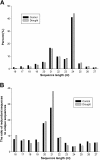Identification of drought-responsive and novel Populus trichocarpa microRNAs by high-throughput sequencing and their targets using degradome analysis
- PMID: 23570526
- PMCID: PMC3630063
- DOI: 10.1186/1471-2164-14-233
Identification of drought-responsive and novel Populus trichocarpa microRNAs by high-throughput sequencing and their targets using degradome analysis
Abstract
Background: MicroRNAs (miRNAs) are endogenous small RNAs (sRNAs) with a wide range of regulatory functions in plant development and stress responses. Although miRNAs associated with plant drought stress tolerance have been studied, the use of high-throughput sequencing can provide a much deeper understanding of miRNAs. Drought is a common stress that limits the growth of plants. To obtain more insight into the role of miRNAs in drought stress, Illumina sequencing of Populus trichocarpa sRNAs was implemented.
Results: Two sRNA libraries were constructed by sequencing data of control and drought stress treatments of poplar leaves. In total, 207 P. trichocarpa conserved miRNAs were detected from the two sRNA libraries. In addition, 274 potential candidate miRNAs were found; among them, 65 candidates with star sequences were chosen as novel miRNAs. The expression of nine conserved miRNA and three novel miRNAs showed notable changes in response to drought stress. This was also confirmed by quantitative real time polymerase chain reaction experiments. To confirm the targets of miRNAs experimentally, two degradome libraries from the two treatments were constructed. According to degradome sequencing results, 53 and 19 genes were identified as targets of conserved and new miRNAs, respectively. Functional analysis of these miRNA targets indicated that they are involved in important activities such as the regulation of transcription factors, the stress response, and lipid metabolism.
Conclusions: We discovered five upregulated miRNAs and seven downregulated miRNAs in response to drought stress. A total of 72 related target genes were detected by degradome sequencing. These findings reveal important information about the regulation mechanism of miRNAs in P. trichocarpa and promote the understanding of miRNA functions during the drought response.
Figures



References
Publication types
MeSH terms
Substances
LinkOut - more resources
Full Text Sources
Other Literature Sources

